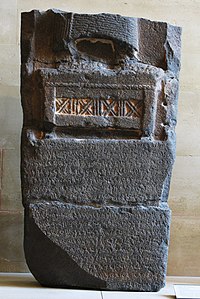Stele of Zakkur

The surviving part of the Stele of Zakkur with the inscription
|
|
| Material | Basalt |
|---|---|
| Height | 62 centimetres (24 in) |
| Width | 13 centimetres (5.1 in) |
| Writing | Aramaic inscription |
| Created | c. 805 – c. 775 |
| Period/culture | Aramaean |
| Discovered | 1903 |
| Place | Tell Afis, Syria |
| Present location | Musée du Louvre, Paris |
| Identification | AO 8185 |
The Stele of Zakkur (or Zakir) is a royal stele of King Zakkur of Hamath and Luhuti (or Lu'aš) in the province Nuhašše of Syria, who ruled around 785 BC.
The Stele was discovered in 1903 at Tell Afis (mentioned in the Stele as Hazrach), 45 km southeast of Aleppo, in the territory of the ancient kingdom of Hamath. It was published in 1907. Its small part reads:
'Bar-Hadad' mentioned in the inscription may have been Bar-Hadad II or Bar-Hadad III, son of Hazael.
Two gods are mentioned in the inscription, Baalshamin and Iluwer. Iluwer was the personal god of king Zakkur, while Baalshamin was the god of the city. It is believed that Iluwer represents the earlier god Mer or Wer going back to 3rd millennium BC.
This inscription represents the earliest Aramaean evidence of the god Baalshamin/Ba'alsamayin.
...
Wikipedia
